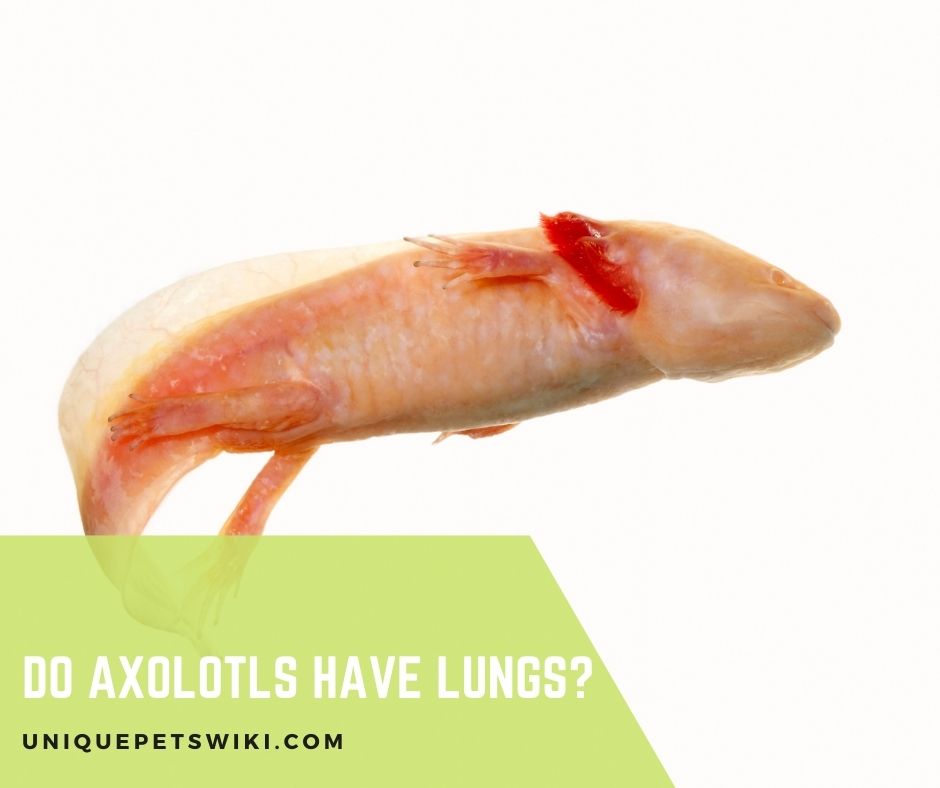Axolotls are amazing and sensitive amphibians. They have certain unusual characteristics, such as the ability to regenerate organs and the ability to breathe both in the water and on land.
Axolotls are salamanders with gills that allow them to breathe in water. Do Axolotls Have Lungs to Breathe and Live on Land?
Axolotls have lungs that allow them to breathe on land, but they are not the same as those found in land animals.
The capacity of an axolotl to breathe on land may be undiscovered to its owners. As a result, it is vital to understand the characteristics and properties of an axolotl’s lungs.
This article will educate readers on how to breathe axolotls in various ways. The post will also explain how axolotl lungs differ from those of other terrestrial animals.
So, read the entire post to learn about the importance of oxygen for axolotls and how to ensure that your axolotl has access to dissolved oxygen.
Contents
Do Axolotls Have Lungs?
Axolotls do have lungs; however, they are underdeveloped and not like those of land animals. Axolotls have sac-like lungs that are encircled by blood vessels.
Axolotls come to the surface and gulp the air when there is a low concentration of dissolved oxygen in the tank.
The exchange of gases happens when air enters the sac-like lungs of axolotls through the capillary network surrounding the lungs.
Because axolotls’ oxygen intake through the lungs is low, this breathing strategy is inefficient in them.
Also read: Do Axolotls Need Air?
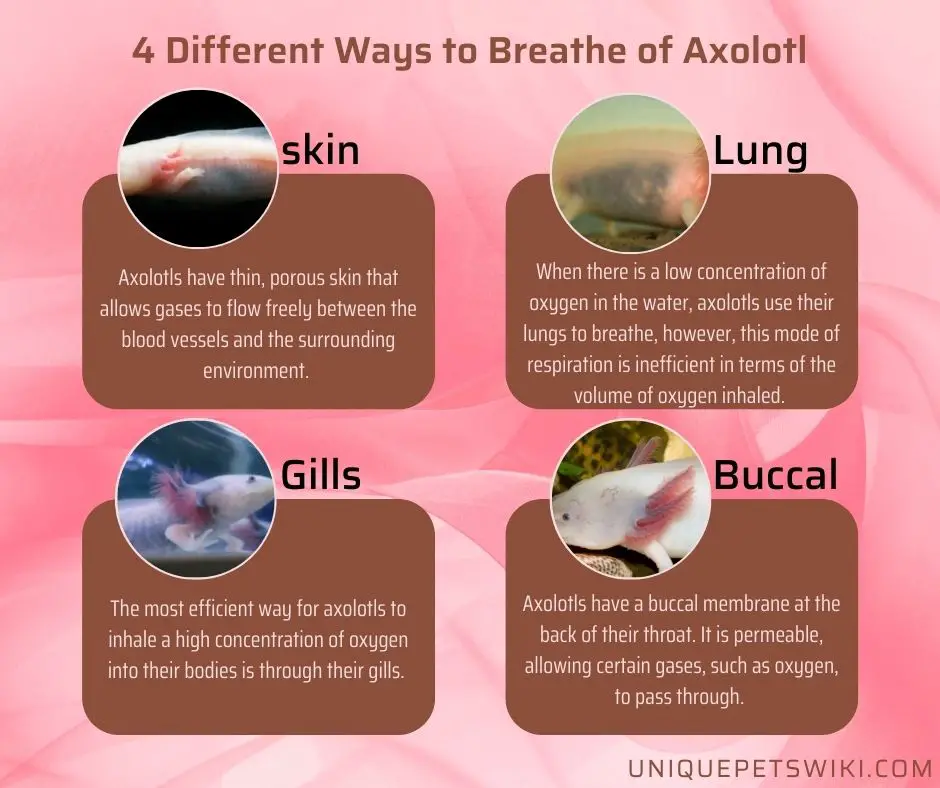
4 Different Ways to Breathe of Axolotl
Axolotls are diversified animals with four different ways of breathing: skin, gills, lungs, and buccal respiration. Axolotls can breathe in a variety of ways at once.
Axolotls ensure the supply of oxygen to their bodies on the surface of water or land by breathing through their lungs and skin.
Axolotls have three pairs of gills that protrude from their bodies to allow them to breathe in water.
The most efficient form of breathing in the water is through the gills, which allows a high concentration of oxygen to enter.
Through Skin
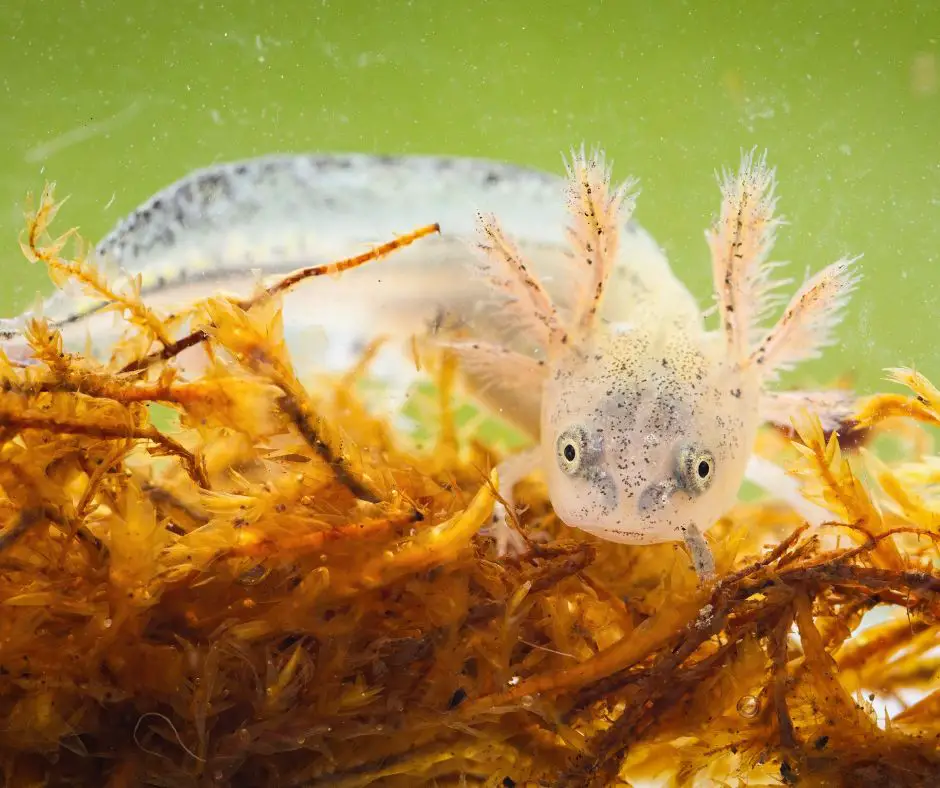
Axolotls have thin, porous skin that allows gases to flow freely between the blood vessels and the surrounding environment.
Axolotls’ wet skin includes oxygen particles that can permeate into blood vessels near the surface. The gaseous exchange is aided by the difference in oxygen and carbon dioxide concentrations.
When the axolotls’ oxygen supply is low, their heartbeat speeds up to ensure that they acquire enough oxygen. Increased heart rate causes blood pressure to rise and blood vessels to widen.
When blood arteries near the skin dilate, they become closer to the skin, allowing oxygen to diffuse from higher to lower concentrations.
When there is a low concentration of oxygen in the tank, this breathing strategy ensures that sufficient oxygen is delivered to the body cells.
All salamanders can breathe through their skin, and some of them can even breathe through their skin while it is dry.
Through Gills
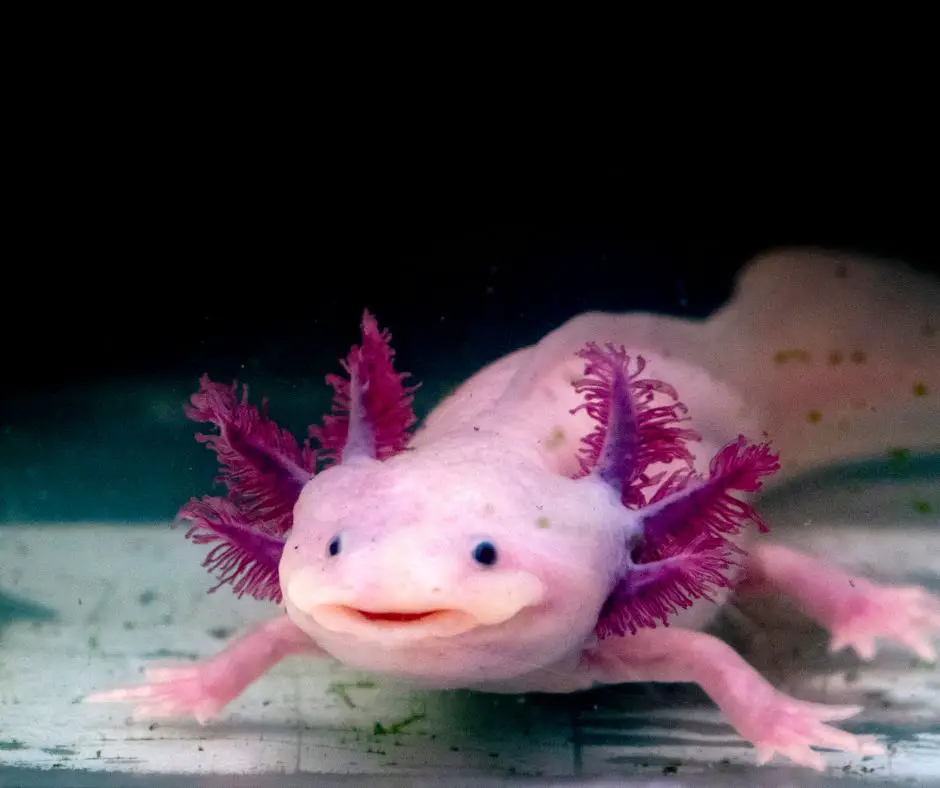
The most efficient way for axolotls to inhale a high concentration of oxygen into their bodies is through their gills.
Gills are found inside the body of most amphibians, such as fish, but axolotls have three pairs of gills that protrude from the body. Gills that are brownish, filamentous, and feathery.
Axolotls have filament-like projections called feathers that protrude from their gills, which is why their gills are also known as feathery gills.
The surface area available for gas exchange between the blood and the environment is increased by feathery gills.
When axolotls move in the water, the exchange of gases through their gills also rises.
Parasites, particulates, and contaminants are kept at bay by axolotls’ feathery gills.
Axolotls’ gills also have sensory receptors that detect impurities in the environment. Fish, sharks, and other aquatic animals have gills for breathing.
hygger Mini Aquarium Air Pump Kit
- Nice Bang for Your Buck — Hygger provides a ready-to-go air pump kit for fish enthusiasts including HG-949 Air pump, 3.6 ft long air tube, 0.9 inch air stone, check valve and user manual (check valve prevent back siphoning)
- Strong Airflow, Low Consumption — Our 1-watt small betta air pump is very energy saving with max flow rate up to 50 gallon per hours, capable of operating small sponge filter and large air stone, creates tons of tiny bubbles, increasing water movement and circulation
- Widely Application — For use with air-driven aquarium accessories like air stone, ornaments and small sponge filters. Mini Aquarium Air Pump only measures 3.5 x 2 x 2 inches. Powerful, lightweight, low noise, along with long service life
- Up to 20 Gal — A great small fish air pump for freshwater and saltwater aquariums and hydroponic systems up to 20 gallon
- Easy to Install — Connect air pump with air tubing, check valve and air stone, less than few minutes installation and you'll good to go
Last update on 2022-12-29 / Affiliate links / Images from Amazon Product Advertising API
Through Lungs
When there is a low concentration of oxygen in the water, axolotls use their lungs to breathe, however, this mode of respiration is inefficient in terms of the volume of oxygen inhaled.
Axolotls have folding pockets that resemble sac-like lungs with blood vessels around them. In the capillaries around the folded spaces of the lungs, deoxygenated blood flows.
The heart receives oxygenated blood from the lungs and distributes it to the rest of the body. Axolotls come to the surface to gulp air when there is a low concentration of oxygen in the water.
When they’re feeling playful, they’ll also come to the surface and gulp the air. However, repeated gulping can indicate a problem with the tank’s water parameters.
Experts believe that axolotls also gulp air to help them float more freely on the water’s surface.
Because they have air in their bodies, their surface area expands, decreasing their body weight and allowing them to float.
Other salamanders have rudimentary lungs that allow them to breathe on land and at the water’s surface.
Buccal Respiration
Axolotls have a buccal membrane at the back of their throat. It is permeable, allowing certain gases, such as oxygen, to pass through.
The oxygen dissolved in water is extracted and delivered to bodily tissues when water passes through the buccal membrane. After then, oxygenated water travels through the filaments of the gills.
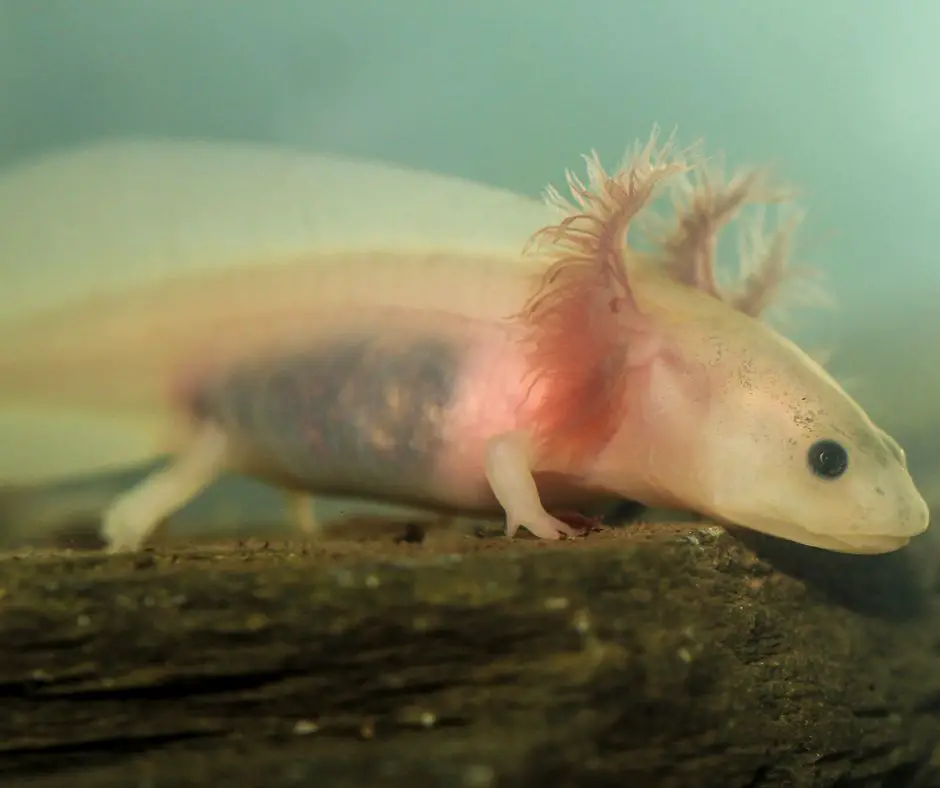
How Long Does Axolotl Hold Its Breath?
Axolotls cannot survive for lengthy periods of time without water. Their bodies are made up of cartilage, which renders them vulnerable.
They have lungs that let them breathe outside of the water, but due to their underdeveloped lungs, they are unable to survive continuously.
Axolotls may survive on land for up to 15 to 20 minutes by breathing through their lungs. This time depends on the humidity outside and the health condition of the axolotl.
Because they have three additional ways to receive oxygen, axolotls can go for years without breathing via their lungs.
Gill respiration is the most efficient way for axolotls to receive enough oxygen. When there is a high quantity of oxygen in the water, axolotls do not surface.
Tips to Have More Oxygen in the Water for Axolotls
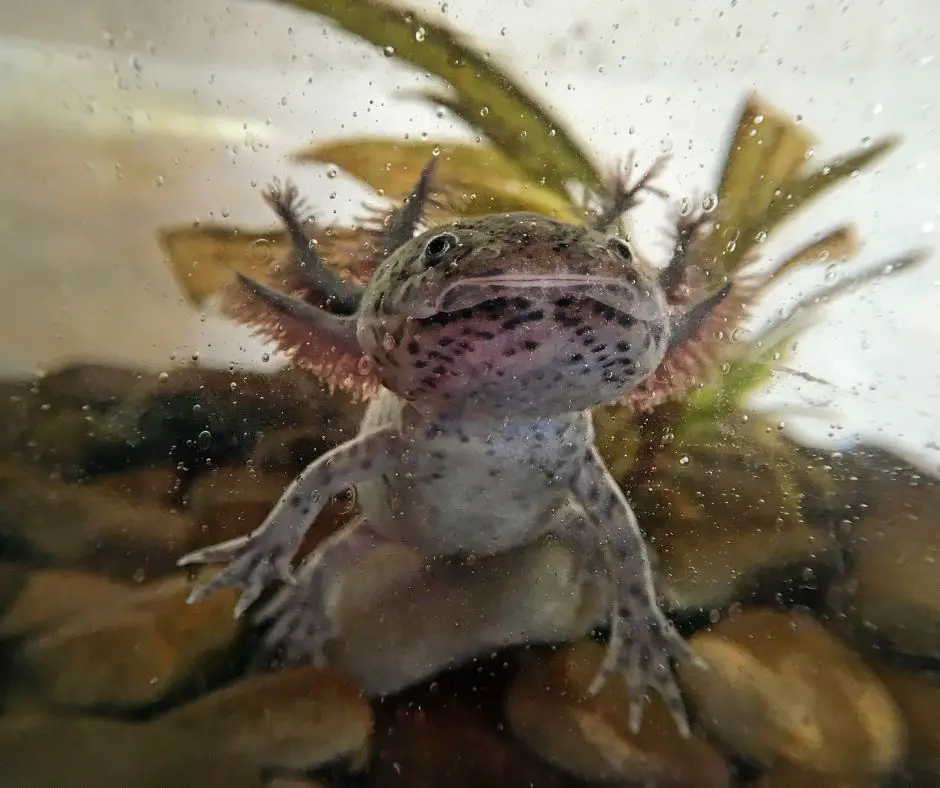
Water filters, bubbles, air pumps, and water stones are some of the methods for maintaining and increasing the concentration of oxygen in the tank.
The elimination of chlorine and chloramine from the water also aids in the improvement of oxygen concentration in the tank.
You can put marine live plants in the tank to keep the axolotls supplied with oxygen on a regular basis.
Live plants utilize carbon dioxide and release oxygen into the water. Air stones are also utilized to keep the oxygen level in the water constant.
To preserve oxygen levels, some owners employ water filters. A water filter can help reduce the quantities of ammonia and nitrates in the water.
Because an increase in ammonia and nitrates in water can stress axolotls and damage their gills. You may also utilize air bubbles in the water tank to provide axolotls with regular oxygen.
It is vital to keep the water flow in the tank smooth because axolotls are sensitive and a strong flow of water can cause stress.
To keep the tank’s oxygen levels stable, food residues and other contaminants must be removed from the water. Axolotls require a constant supply of oxygen, which is ensured by regular water changes.
Also read: Full Requirements & Water Conditions for Axolotl in Captivity
VIVOSUN 317-1750GPH Commercial Air Pump
- Premium Materials & Great Heat Control: This pump dissipates heat more effectively with aluminum-alloy heat-radiating plates, and delivers excellent, long-lasting performance with a high-quality aluminum manifold and 100% copper outlet nozzle
- Maximum Air Pressure and Air Volume: VIVOSUN powerful 50W electromagnetic motor produces exceptional air pressure (over 0.035 MPa) and sends a huge volume of air to the 8 adjustable valve outlets (compatible with 1/4" air lines)
- Set It and Forget It: Innovative material engineering on the steel engine column and piston makes this pump perfectly energy-efficient and highly resistant to wear-and-tear so you can leave it running 24/7; recommended for outdoor use
- Quiet Solution for Hydroponics and Fish Tanks: This model's oil-free motor lubrication, low noise generation (under 60 decibels) and 1.5 m. power cord make it the ideal pump for oxygenating an aquarium or plant roots in a hydroponics system
- Great Performance: Pumping 70 liters of air per minute rated for up to 1 year of service, this pump is the reliable solution you've been looking for
Last update on 2022-12-29 / Affiliate links / Images from Amazon Product Advertising API
Final Words
Rudimentary lungs are sac-like lungs found in axolotls. When there is a low concentration of oxygen in the water or when they are out of it for an extended period of time, they use their lungs to breathe.
Axolotls can gulp air from the water’s surface due to their lungs. The oxygen in the air is then distributed to the lungs’ blood capillaries.
Axolotls have three other methods for breathing including skin, gills, and buccal respiration.
Axolotls require consistent oxygen availability to survive, hence they have four strategies for dealing with an oxygen shortage.
To maintain the oxygen concentration in the tank, you can use water, filters, air bubbles, water stones, and water plants.
